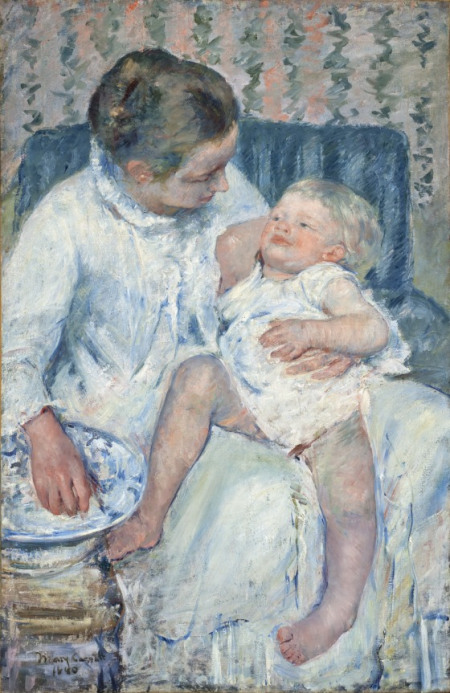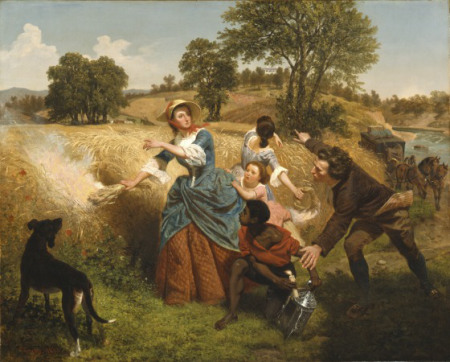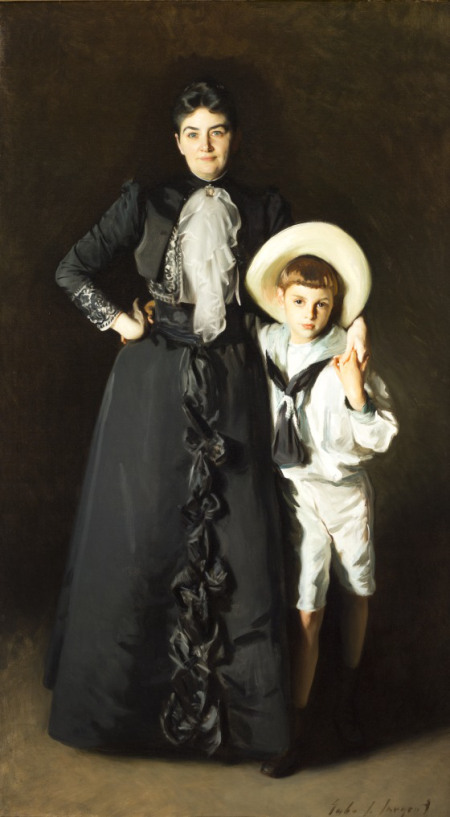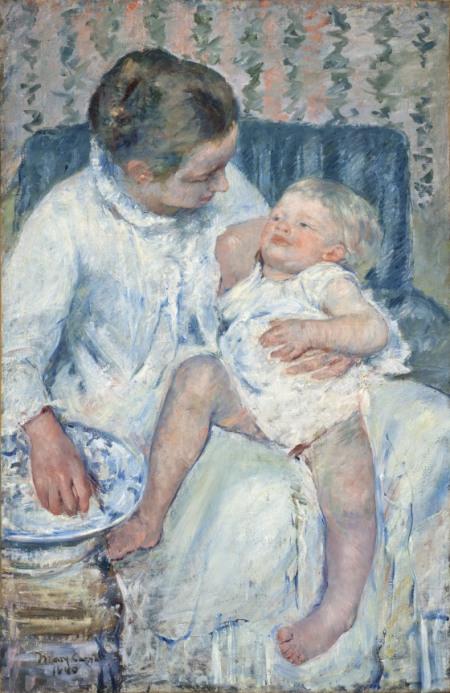Mother’s Day is Sunday, and LACMA will mark the day with a special Mother’s Day brunch and dinner, offered by the Patina Restaurant Group. Other activities will include a full slate of family-oriented NexGen art-making activities, beginning at 12:30 pm. Galleries will be open starting at 10 am, and the museum’s permanent collection includes some wonderful mother-and-child paintings. We asked director of adult programs and art historian Mary Lenihan to discuss some of them.
A mere mention of the mother-and-child theme brings one artist’s name instantly to mind: Mary Cassatt. Her tender depictions of this theme have made her paintings among the most beloved in any museum collection. LACMA has what might be her very first such treatment, Mother About to Wash Her Sleepy Child, from 1880. I feel almost remiss in mentioning it, since it currently is on tour with other museum objects in Korea and Australia, so visitors here can’t see it right now. But it is a museum favorite, and certainly a shining star of the collection, so I can’t omit it from this list.
 Mother About to Wash Her Sleepy Child, Mary Cassatt,
Mother About to Wash Her Sleepy Child, Mary Cassatt,United States, 1880, Mrs. Fred Hathaway Bixby Bequest
Notice the immediacy and the intimacy of the painting, hallmarks of the Impressionist movement, in which Cassatt played an important role. She cropped the scene, even cutting off the sides of the chair, so we feel as if we are right there with the mother as she affectionately holds her child. The painting is not at all static – the mother’s hand, poised with a wet washcloth, anticipates motion, while the child’s left arm, slightly blurred, seems to move. The colors—cream, pink and warm grays and blues—suggest a Victorian-era nursery, as do the upholstery fabric and the wallpaper.
Cassatt, an American woman, was a full-fledged member of the French Impressionist circle starting in the 1870s in Paris. A friend of Edgar Degas, she exhibited alongside the others in the group, and absorbed many of the elements that infused their work: a lightened palette, rich background patterns, unconventional perspective, and feathery brushstrokes. Because Cassatt tended to use conventional “feminine” subject matter, such as family scenes and women taking tea, her canvases were actually underappreciated during the decades following her death in 1926. Around 1980, art historians began to re-examine her work, noting that while her subject matter might have been traditional, her technique was modern and daring. One does not need to know much about art history to appreciate her paintings; looking at LACMA’s canvas, we can simply revel in the gorgeous colors and convincing emotion, which Cassatt painted without succumbing to the obvious sentimentality that lesser artists might use with such a scene.
 Mrs. Schuyler Burning Her Wheat Fields on the Approach of the British, Emanuel Gottlieb Leutze, United States, 1852, Bicentennial gift of Mr. and Mrs. J. M. Schaaf, Mr. and Mrs. William D. Witherspoon, Mr. and Mrs. Charles C. Shoemaker, and Jo Ann and Julian Ganz, Jr.
Mrs. Schuyler Burning Her Wheat Fields on the Approach of the British, Emanuel Gottlieb Leutze, United States, 1852, Bicentennial gift of Mr. and Mrs. J. M. Schaaf, Mr. and Mrs. William D. Witherspoon, Mr. and Mrs. Charles C. Shoemaker, and Jo Ann and Julian Ganz, Jr.
Mrs. Schuyler Burning Her Wheat Fields on the Approach of the British by American artist Emanuel Leutze might seem an odd choice to include in this Mother’s Day blog, but it depicts a mother doing what most any mother would do: heroically protecting and defending her family. This painting is currently on view on the third floor of the Art of the Americans Building, and is worth a long look.
Painted in 1852, the scene is actually one from the American Revolution, 75 years earlier. Museum staff and docents use it frequently in gallery tours, and many school children who tour the collection have no trouble at all deciphering the theme; the fact that most of the figures are clad in red, white, or blue signals that it is a patriotic American story. Without knowing the actual narrative, or even what era it dates from, children also outline the tale by looking closely at the figures’ dramatic body language and facial expressions. They rightly surmise that the central woman is a mother surrounded by two similarly clad daughters, one of whom clings to her fearfully. A stagecoach, packed and ready, stands nearby. A helpful neighbor gestures to the distant hillside, while a servant kneels with a candle in the forefront.
This scene is based on a popular story that circulated in the nineteenth century, that of the heroic wife of General Philip Schuyler, leader of revolutionary forces. He has sent word to his wife that the British army was marching down the Hudson River towards New York City. The family farm lay right in its path. The artist shows the moment when, after packing family belongings, Mrs. Schuyler prepares to lead her children to safety. First, though, she stops to torch her farm’s ripened wheat fields, so that the British will not be able to make bread for its soldiers. The story, based on an account by Mrs. Schuyler’s youngest daughter, was anthologized in books popular in the 1840s and 50s. Historians cannot confirm that this event actually took place, but it is an example, nevertheless, of the resolute strength of an American mother.
 Portrait of Mrs. Edward L. Davis and Her Son, Livingston Davis, John Singer Sargent, United States, 1890, Frances and Armand Hammer Purchase Fund
Portrait of Mrs. Edward L. Davis and Her Son, Livingston Davis, John Singer Sargent, United States, 1890, Frances and Armand Hammer Purchase Fund
The third painting, Mrs. Edward L. Davis and Her Son, Livingston Davis, from 1890, is an example of yet another way artists have depicted the mother-and-child theme. The Cassatt painting is what we might call a “genre painting,” an everyday scene of modern life. Scholars classify Leutze’s canvas a “history painting.” John Singer Sargent’s painting is a portrait; he was hired to paint the likeness of Mrs. Davis and her son, who were part of an influential family in Worcester, Massachusetts.
Sargent, an American artist who spent much of his life in Europe, was from a wealthy expatriate family with strong connections to other affluent Americans living abroad. He anchored a lively circle of European and American writers, intellectuals and aristocrats. By 1890, many considered him the best portrait painter in London. He made several extended visits to the United States, where he was promptly flooded with offers of portrait commissions. He completed the Davis painting in two weeks, during one of these visits.
Just as the Cassatt painting is considered one of the artist’s best paintings of its type, the Sargent painting is considered by many to be one of Sargent’s best portraits. Part of the museum’s collection since 1969, it is another favorite of museum visitors, and is on view on the third floor of the Art of the Americas Building.
Notice that the artist painted Mrs. Davis in a way that conveys her wealth and social importance, depicting her with a confident gaze, regal bearing, and fashionable dress. Her maternal role is also evident; her arm protectively surrounds her son, with their hands intertwined. Young Livingston, age 8 at the time, appears a bit shy, but his mother’s friendly, open facial expression communicates warmth and affection. A double portrait challenges an artist, since one figure must not overshadow another. In this case, Sargent succeed wonderfully; the poses, setting, and clothing combine to effectively capture each individual, but also signal Mrs. Davis’s fulfillment of one of the principal functions of a late-nineteenth century woman, the role of affectionate mother.
Visit LACMA on Sunday to see the Sargent and Leutze paintings, along with all the other wonderful art currently on display. Enjoy the day with your family!
Mary Lenihan



